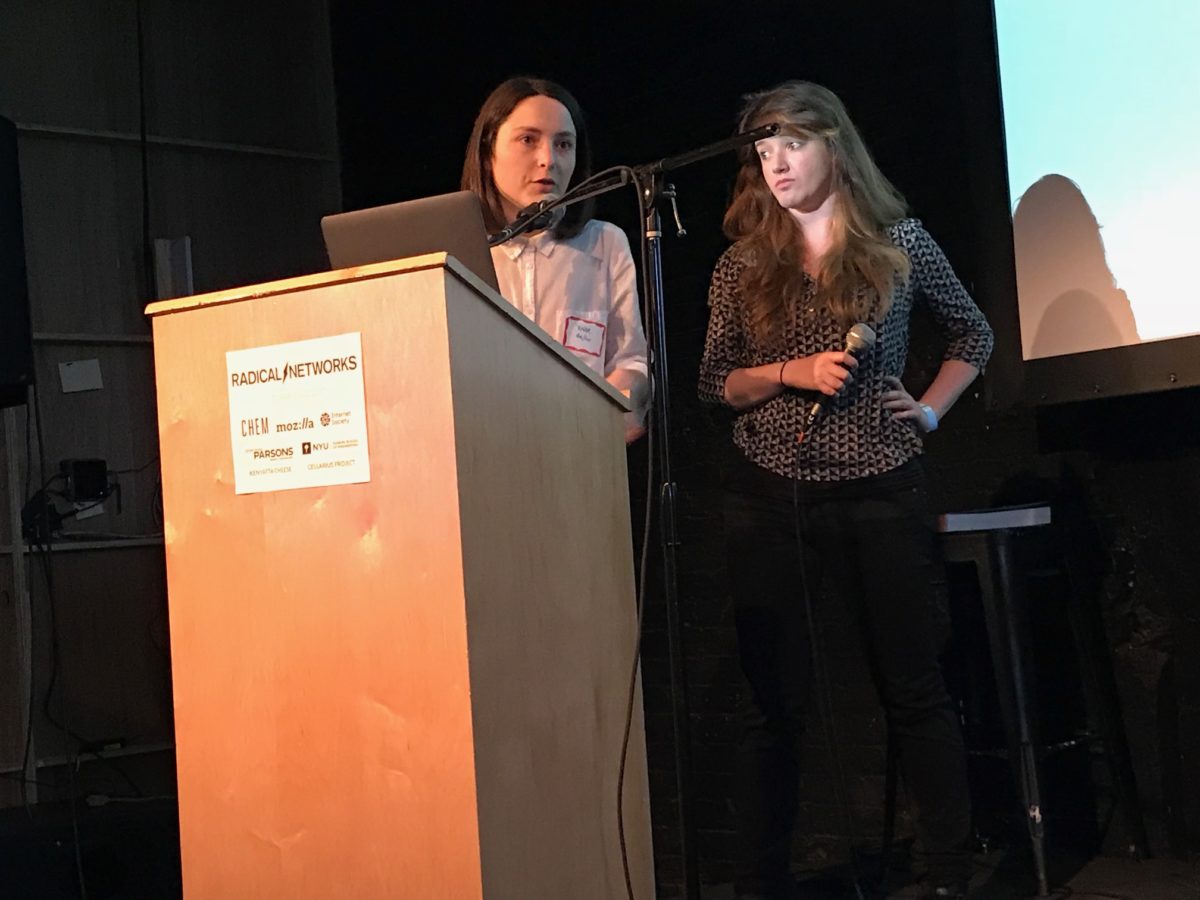Anti-gentrification protesters rallied outside the Brooklyn Museum as it hosted the Brooklyn Real Estate Summit in 2015. Afterward, museum staffers asked protesters if they could show some of their props at an exhibition about recent neighborhood battles. That was then, but now artists in San Francisco are experiencing a similar arc as they used the web to infiltrate another major art institution in California.
The team behind the Unauthorized SFMOMA Show hoped for a lawsuit as they put together a three-month series of solo exhibitions designed for the public space inside the San Francisco Museum of Modern Art.
Ana María Montenegro Jaramillo and Enar de Dios Rodríguez (who put together the project with their colleague Lasse Scherffig) presented the story of their project last Friday at the Radical Networks conference in Bushwick, an annual festival that fosters critical discussion about technology’s perils and promise.
The artists had first arrived in San Francisco while the museum was closed for a three-year redesign and expansion. It re-opened on May 14 and everything about it impressed them, including its admission price of $25. “Already SFMOMA was drawing a big line between who could visit and who couldn’t,” Rodriguez said.
While the space itself was gigantic, most of it was closed off to the non-ticket holding public except a large lobby area that housed a few large works by extremely well-established artists.
“Is this really what we need?” Rodriquez asked. “How can we occupy the museum?”
They decided to make a website that could only be viewed if the visitor’s mobile device registered a geolocation on the grounds of SFMOMA. When it registered the location, it showed a site that very much imitated (but did not exactly copy) the look of the SFMOMA website. It asked the visitor if they would like to visit the “Unauthorized SFMOMA Show” or if they would like to exhibit work in the show.
— Unauth. SFMOMA Show (@unsfmomashow) April 8, 2017
The team took a photo of the wall where the submitted works would show. The photo even included the edge of Richard Serra’s walk-in sculpture, Sequence, located in the same public space where the virtual show took place.
If someone chose to visit the exhibition, they would see the current work on display, shown as if it were hanging on an actual SFMOMA wall. If they chose to have their own show, they were prompted to submit a two-dimensional file in format like JPEG or GIF. Software would then copy that image into their photo and it would replace the prior exhibition.
No one on the team looked at or approved works as they went up. When a new work was submitted, a new solo show had begun.
I had an unauthorized SFMOMA show today c/o @unsfmomashow: https://t.co/2irMOzVdSG pic.twitter.com/CUKkzarzgb
— Eryk Salvaggio (@e_salvaggio) April 17, 2017
“There were no curatorial guidelines. Everything that was submitted was shown,” Jaramillio said. They showed a timeline of all the exhibitions. The first artists to submit stayed up longer. As word spread, though, shows became shorter and shorter as more artists wanted to have work up before the project ended.
The unauthorized show ran from April 6 into July, because generally speaking that’s roughly how long shows sanctioned by the museum run.
“People surprisingly took it super seriously,” Jaramillio said. They thought they’d get mocking submissions, but by and large it was all serious artwork.
“It’s important that it’s a solo show,” Rodriguez explained, because lesser known artists have a hard time getting solo shows.
Like the Brooklyn protesters, after it was all over, the artists heard from people in curatorial side of the museum. The digital department was impressed by what they had done and wanted to talk about it with them more.
The marketing department, they would later learn, had been less happy about the show. In fact, some said that the museum had looked into suing the then-anonymous collaborators, but it was hard to find a real infraction to hold against them. Everything they did indicated it wasn’t an approved show.
And though they did everything they could to imitate the museum, they never directly copied it.
“We weren’t using their actual red, just a very close one,” Jaramillo said, by way of example. “And we weren’t using their actual font, just a very close one.”

A collection of works from the Unauthorized SFMOMA Show. (Photo by Brady Dale)
Join the conversation!
Find news, events, jobs and people who share your interests on Technical.ly's open community Slack
